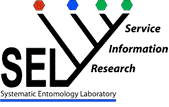Entomology Collections, General

USDA Systematic Entomology Laboratory
Document Type
Article
Date of this Version
2009
Abstract
Cynipini gall wasps (Hymenoptera: Cynipidae) are commonly known as oak gall wasps for their almost exclusive use of oak (Quercus spp.; Fagaceae) as their host plant. Previously, only three of the nearly 1,000 species of Cynipini have been recorded from hosts other than Quercus. These three are known from western chinquapin (Chrysolepis), chestnut (Castanea) and tan bark oak (Lithocarpus), all lineages of Fagaceae related to Quercus. Here we describe Dryocosmus rileypokei Morita & Buffington, new species, a second species of cynipine which attacks Chrysolepis. Unlike the previously known gall wasp D. castanopsidis, which producesa medium-sized spherical external gall near the base of the staminate (male) flowers of Chrysolepis sempervirens, D. rileypokei attacks the same host acting as a nut galler. Dryocosmus rileypokei creates a gall within the mesocarp wall of the nut and appears to draw nutrients away from the developing seed. Later instar larvae and teneral adults were found within these internal galls. It appears that the adult wasp eventually chews an exit hole from these galleries. The evolution of host use in the three, non-oak galling Dryocosmus species is discussed.


Comments
Published in PROC. ENTOMOL. SOC. WASH. 111(1), 2009, pp. 244–253